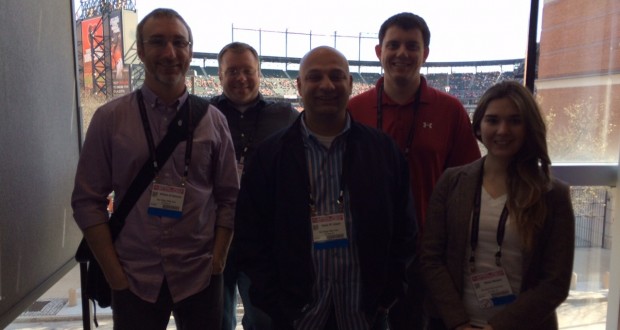 SDSU Computational Science and Physics students (left to right) William Spinella, Martin Kandes, Omair Zubairi, Micah Schuster, and Alexis Romero attended the 2015 April American Physical Society (APS) meeting held in Baltimore, MD. Each student gave oral presentations on their current work conducted at SDSU. See below for their abstracts.
SDSU Computational Science and Physics students (left to right) William Spinella, Martin Kandes, Omair Zubairi, Micah Schuster, and Alexis Romero attended the 2015 April American Physical Society (APS) meeting held in Baltimore, MD. Each student gave oral presentations on their current work conducted at SDSU. See below for their abstracts.
William Spinella (Numerical Astrophysics):
Advisor: Dr. Fridolin Weber
Abstract:
Neutrino-pair bremsstrahlung due to interactions between electrons and the crystalline lattice in the quark-hadron mixed phase of high mass neutron stars has been previously studied by Na et al. 2012. We extend this study by first replacing the MIT bag model with the nonlocal three-flavor Nambu-Jona-Lasinio model to describe the quark matter phase. We then include rod and slab rare-phase geometries in addition to spherical blobs. Finally we compare contributions due to Bragg diffraction and electron-phonon scattering. We find that the neutrino emissivity due to electron-lattice interactions in the mixed phase may be substantial at low temperature and quark fraction.
Martin Kandes (Bose-Einstien Condensates)
Advisor: Dr. Ricardo Carretero
Abstract:
We present the implementation of a method-of-lines approach for numerically approximating solutions of the time-dependent Gross-Pitaevksii equation in non-uniformly rotating reference frames. Implemented in parallel using a hybrid MPI + OpenMP framework, which will allow for scalable, high-resolution numerical simulations, we utilize an explicit, generalized 4th-order Runge-Kutta time-integration scheme with 2nd- and 4th-order central differences to approximate the spatial derivatives in the equation. The principal objective of this project is to model the effect(s) of inertial forces on quantized vortices within weakly-interacting dilute atomic gas Bose-Einstein condensates in the mean-field limit of the Gross-Pitaevskii equation. Here, we discuss our work-to-date and preliminary results.
Omair Zubairi (Numerical Astrophysics)
Advisor: Dr. Fridolin Weber
Abstract:
Conventional models of compact objects such as neutron stars assume they are perfect spheres. However, due to high magnetic fields, certain classes of neutron stars such as magnetars and neutron stars containing color-superconducting quark matter cores are expected to be deformed (non-spherical). In this work, we seek to examine the stellar structure of such objects in the framework of general relativity. We derive the stellar structures equations of non-spherical neutron stars and calculate stellar properties such as masses, radii, along with pressure and density profiles and investigate any changes from standard spherical models.
Micah Schuster (Nuclear Physics)
Advisor: Dr. Calvin Johnson
Abstract:
A goal of nuclear theory is to make quantitative predictions of low-energy nuclear observables starting from accurate microscopicinternucleon forces. Modern effective interaction theory, applying unitary transformations to soften the nuclear Hamiltonian and hence accelerate the convergence of ab initio calculations as a function of the model space size, is a major element of such an effort. The consistent simultaneous transformation of external operators, however, has been overlooked in applications of the theory, particularly for non-scalar transitions. We study the evolution of the electric dipole operator in the framework of the similarity-renormalization group method and apply the renormalized matrix elements to the calculation of the 4He total photo absorption cross section and electric dipole polarizability. All observables are calculated within the ab initio no-core shell model. We find that, although seemingly small, the effects of induced operators on the photo absorption cross section are comparable in magnitude to the correction produced by including the three-nucleon force and cannot be neglected.
Alexis Romero (Numerical Astrophysics)
Advisor: Dr. Fridolin Weber
Abstract:
Non-rotating neutron stars are generally treated in theoretical studies as perfect spheres. Such a treatment, however, may not be correct if strong magnetic fields are present and/or the pressure of the matter in the cores of neutron stars is non-isotropic, leading to neutron stars which are deformed. In this work, we investigate the impact of deformation on the gravitational redshift of neutron stars in the framework of general relativity. Using a parameterized metric to model non-spherical mass distributions, we derive an expression for the gravitational redshift in terms of the mass, radius, and deformity of a neutron star. Numerical solutions for the redshifts of sequences of deformed neutron stars are presented and observational implications are pointed out.

